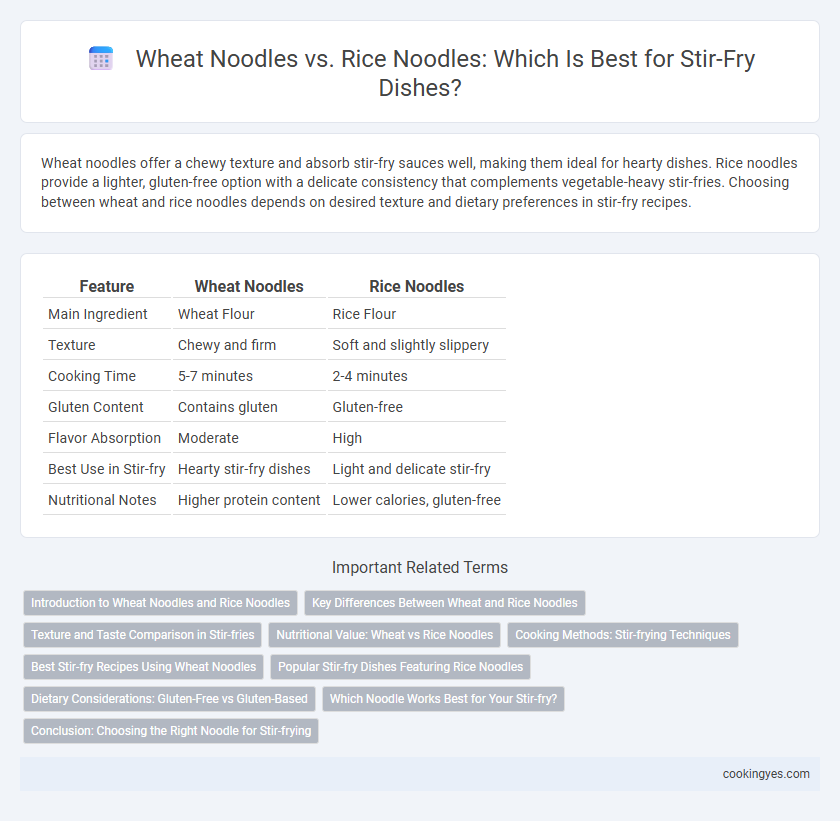Wheat noodles offer a chewy texture and absorb stir-fry sauces well, making them ideal for hearty dishes. Rice noodles provide a lighter, gluten-free option with a delicate consistency that complements vegetable-heavy stir-fries. Choosing between wheat and rice noodles depends on desired texture and dietary preferences in stir-fry recipes.
Table of Comparison
| Feature | Wheat Noodles | Rice Noodles |
|---|---|---|
| Main Ingredient | Wheat Flour | Rice Flour |
| Texture | Chewy and firm | Soft and slightly slippery |
| Cooking Time | 5-7 minutes | 2-4 minutes |
| Gluten Content | Contains gluten | Gluten-free |
| Flavor Absorption | Moderate | High |
| Best Use in Stir-fry | Hearty stir-fry dishes | Light and delicate stir-fry |
| Nutritional Notes | Higher protein content | Lower calories, gluten-free |
Introduction to Wheat Noodles and Rice Noodles
Wheat noodles, made from wheat flour and water, offer a chewy texture and robust flavor ideal for absorbing stir-fry sauces. Rice noodles, crafted from rice flour and water, provide a light, delicate consistency that cooks quickly and pairs well with savory and spicy stir-fry dishes. Both noodle types vary in thickness and shape, influencing their taste and cooking times in Asian culinary applications.
Key Differences Between Wheat and Rice Noodles
Wheat noodles have a denser texture and higher gluten content, making them more elastic and ideal for stir-fry recipes that require a chewy bite. Rice noodles are naturally gluten-free with a lighter, softer texture that absorbs sauces quickly, perfect for delicate stir-fry dishes. The nutritional profile also differs: wheat noodles provide more protein and fiber, while rice noodles offer lower calories and a milder flavor.
Texture and Taste Comparison in Stir-fries
Wheat noodles offer a chewy, firm texture that holds up well in stir-fries, providing a satisfying bite and absorbing savory sauces effectively. Rice noodles deliver a softer, more delicate texture with a subtle, slightly sweet flavor that complements lighter stir-fry ingredients without overpowering them. The choice between wheat and rice noodles in stir-fries depends on desired mouthfeel and flavor intensity, with wheat noodles favored for robustness and rice noodles preferred for a tender, mild experience.
Nutritional Value: Wheat vs Rice Noodles
Wheat noodles contain higher protein and fiber content compared to rice noodles, making them more filling and beneficial for muscle repair and digestion. Rice noodles are lower in calories and gluten-free, suitable for individuals with gluten intolerance or those seeking lighter meals. Both types offer unique nutritional benefits, with wheat noodles providing more complex carbohydrates and rice noodles offering easier digestibility.
Cooking Methods: Stir-frying Techniques
Wheat noodles maintain their firm texture and absorb sauces well when stir-fried over high heat with quick tossing, making them ideal for traditional stir-fry dishes. Rice noodles require careful timing and lower heat to prevent breaking, often needing to be soaked or pre-cooked before stir-frying for optimal texture. Mastering these specific stir-frying techniques enhances the flavor and mouthfeel of both wheat and rice noodles in Asian cuisine.
Best Stir-fry Recipes Using Wheat Noodles
Wheat noodles are ideal for stir-fry recipes due to their firm texture and ability to absorb bold sauces like soy and hoisin without becoming soggy. Popular dishes such as chow mein and lo mein showcase how wheat noodles maintain a chewy bite that complements stir-fried vegetables, meats, and savory seasonings. Their elasticity and resistance to breaking apart under high heat make them the preferred choice for authentic and flavorful stir-fry dishes.
Popular Stir-fry Dishes Featuring Rice Noodles
Rice noodles are a staple in popular stir-fry dishes such as Pad Thai, Char Kway Teow, and Drunken Noodles, prized for their light texture and quick cooking time. Unlike wheat noodles, rice noodles absorb sauces and flavors more readily, enhancing the overall taste of dishes featuring bold, savory sauces and fresh herbs. Their gluten-free composition makes them a favored choice in Southeast Asian cuisine, providing a chewy yet tender bite that complements stir-fried vegetables and proteins.
Dietary Considerations: Gluten-Free vs Gluten-Based
Wheat noodles contain gluten, making them unsuitable for individuals with celiac disease or gluten sensitivity, whereas rice noodles are naturally gluten-free, offering a safe alternative for a gluten-free diet in stir-fry dishes. The carbohydrate content in rice noodles is generally higher, providing a lighter texture compared to the denser, chewier wheat noodles which have a higher protein content. Selecting between wheat and rice noodles for stir-fry should consider dietary restrictions, with rice noodles favored for gluten intolerance and wheat noodles preferred for those seeking added protein.
Which Noodle Works Best for Your Stir-fry?
Wheat noodles, such as lo mein or chow mein, maintain a firm texture and absorb sauces well, making them ideal for hearty stir-fries with robust flavors and vegetables. Rice noodles, including pad Thai or vermicelli, offer a lighter, chewier bite and are better suited for stir-fries with delicate ingredients or Asian-style sauces like fish sauce and tamarind. Choosing between wheat and rice noodles depends on the desired texture and flavor profile of your stir-fry dish.
Conclusion: Choosing the Right Noodle for Stir-frying
Wheat noodles offer a chewy texture and strong structure ideal for stir-frying, holding up well to high heat and robust sauces. Rice noodles provide a delicate, slightly chewy bite with a lighter taste that absorbs flavors quickly but can be prone to breaking if overcooked. Selecting between wheat and rice noodles depends on desired texture and sauce compatibility, with wheat noodles generally preferred for traditional stir-fry dishes requiring resilience and hearty mouthfeel.
Wheat noodles vs Rice noodles for Stir-fry Infographic

 cookingyes.com
cookingyes.com